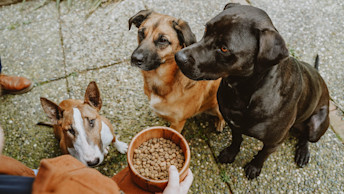March 29, 2013
Feeding FAQs

What is the best way to transition my pet to your foods?
It's important to slowly transition your pet to a new food so their system has a chance to adapt to the change.
The transition period should be at minimum, ten days and could take upwards of two weeks, depending on your pet's sensitivity to change.
Food transition steps
- On day one, introduce 10% new food / 90% old food. Keep the food at this ratio for two or more days.
- Next, increase the ratio to 20% new food / 80% old food for two or more days.
- Repeat increasing in increments of 10% until you're feeding 100% of the new food.
If your pet experiences any kind of digestive upset during this time, try slowing down the process to let his/her digestive tract adjust to the new food. Some digestive upset can be common when introducing new foods. If you experience any vomiting and/or diarrhea, be sure to reduce the amount of new food the next time you feed and overall, slow the whole transition period down even more.
I followed the feeding guidelines on your packaging, but my pet is too fat/thin. Why?
Feeding Guidelines are simply a place to start. You should increase or decrease the amount you feed based on your pet's activity level and weight. If you need additional assistance, please call our Health and Nutrition Specialist toll-free at 1.866.864.6112.

Is it okay to wet the dry food with warm water?
Yes, often a little warm water on the kibble will encourage a picky dog to eat because of the yummy aroma the warm water releases. However this often does not work for cats.
My pet is allergic to chicken. Can I still feed him a formula containing chicken fat?
Yes, the molecular structure of fat is different than protein and chicken fat, therefore, shouldn't bother a pet with a chicken allergy.


